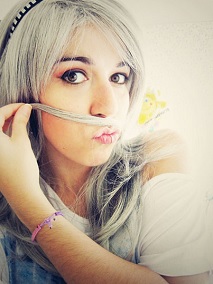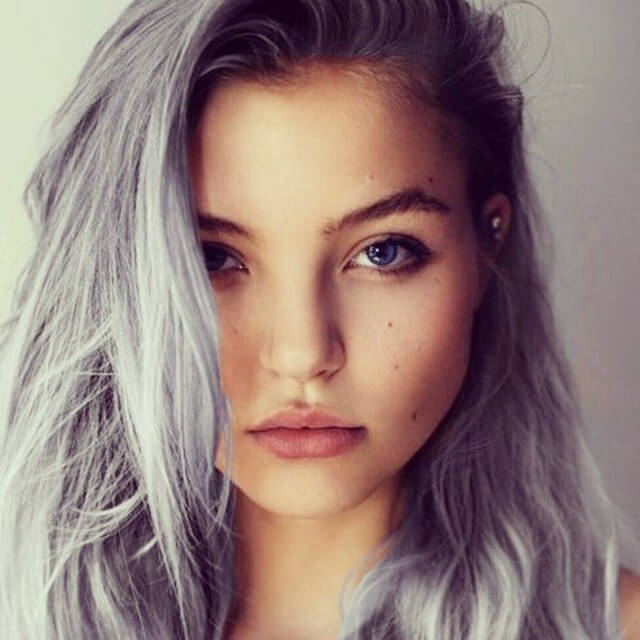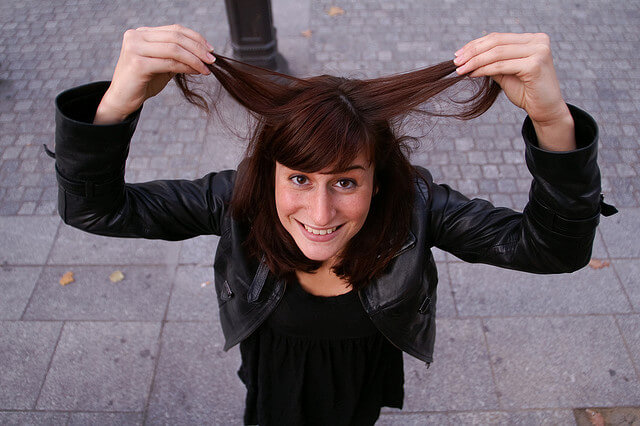
|
| [1] |
How is gray hair different?
Hair gets its natural color from a pigment called melanin which is produced by specialized cells in each hair follicle. Gray hair is different from colored hair as it lacks this pigment. This is because the melanin fails to be produced, and the cause can be due to aging, illness, medications, or even stress. Largely however, it is determined by genetics and you can't prevent your hair from eventually graying.
This lack of melanin results in clear hair which has no color. The amount of this clear hair is what determines whether your hair looks gray or fully white as the larger a percentage of gray hair you have, the whiter your overall color will look. The more gray you have, the more difficult it tends to be to color it properly as well.
There are a few reasons why this is the case. Gray hair is coarser and thus more resistant to coloring. Whatever color you try to add to it, less will usually penetrate into gray hair compared to the rest of your hair, and it fades quicker as well.
The most important reason why it won't color properly however, is because of the lack of pigment in gray hair, and this is key to deciding on the best hair color to cover gray.

|
| [2] |
Filling hair
If you've ever lightened your hair from a darker color to a much lighter shade, you will have noticed the underlying pigment is revealed during lightening. This means that a dark brown color for example, will transition from its original brown color to a deep red, and then gradually to a brighter red, to orange, to gold, and finally to increasingly paler shades of yellow.
This underlying pigment is the base tone in your hair and what gives it the foundation and depth it needs to look the color it does. The actual color you see is a combination of that rich base tone and the cool pigment on the surface of the color that gives it a realistic hair color.
When you decide to go from a light color to a darker color, the opposite occurs and you must replace this missing base tone in order to achieve the new color as this foundation is missing. This is exactly what happens with gray hair and why it can be so frustrating to color. If the base tone isn't replaced properly in gray hair it can grab onto certain tones and produce a strange color result, or fade rapidly after coloring.

|
| [3] |
How to fill hair
You can fill your hair a few different ways, but the two most common and easiest methods are either to use a demi-permanent dye or a protein filler.
Protein fillers are less diverse but easier and quicker to use as they are applied, allowed to absorb, and the desired color can merely be applied on top of this. They are also beneficial where your hair is porous or damaged as the protein bonds to porous and weakened areas to allow for a more even result and less fading.
Demi-permanent dye, on the other hand, must be used separately to the desired color by applying and allowing to develop and then rinsing prior to dyeing with a permanent dye to finish the color. However, given the abundance of shades available, it is easier to match the depth and color needed for the right base tone of any color you want.
As a rule, fill with the color that is the base tone for the shade you want. When using protein filler, use a filler designed for blonde or brown hair for the particular result you want, as well as the right color as if the filler is too dark, the base tone will persist into the final color. For demi-permanent color however, use the base tone color for your desired color, at 1 - 2 levels lighter as the filler.
| Level | Base tone |
|---|---|
| 1. Black | Red |
| 2. Off-black / darkest brown | Red |
| 3. Dark brown | Red-orange |
| 4. Medium brown | Orange-red |
| 5. Light brown | Orange |
| 6. Dark blonde | Gold-orange |
| 7. Medium blonde | Gold |
| 8. Light blonde | Yellow |
| 9. Very light blonde | Light yellow |
| 10. Lightest blonde | Pale yellow |
Using a natural/neutral tone dye
Another way to deal with the missing base tone is to use a natural or neutral toned dye. Both of these terms generally mean the same thing and shades in a natural tone contain all three primary colors rather than being dominant in one particular tone.
What this balance of color means is that the dye is better able to darken pale hair as it is adding balanced color to hair that contains no color. If you were to apply a red dye for example, and your hair is roughly 30 percent gray, what happens is that your natural color will dye properly and take on a rich, deep red color. Your gray hair on the other hand, takes on a bright red color, but does not darken much.
To get around this problem, it is very simple to either just apply a natural tone, or to use a natural tone mixed half and half with the tone you actually want. Natural toned dyes are the best hair color to cover gray because of their balance of tones and this will give you maximum gray coverage beyond what even the best gray hair dyes in other shades are able to offer.

|
| [4] |
Filling vs natural dye
Knowing the benefits of both filling and the use of a natural tone dye begs the question of whether the two techniques are interchangeable. They're not though. Filling will generally always be superior because it provides a better approximation of the missing base tone and works properly in most situations.
Dyeing with a natural dye is better than dyeing with any other dye, but the darker the color you want to go, and the more gray hair you have, the better it begins to be to fill prior to dyeing rather than use a dye alone
More information:
- How to color hair - More information about dyeing your hair and using hair dye...
- How to choose hair color - Find out how to match your color to your features and choose a shade that will look good...
- Using salon hair dye - Salon dye has many benefits over box dye. Find out how to prepare and apply professional hair dye...
Do you have a question about the best hair color to cover gray, or need help dyeing your own gray hair? Leave a comment for tailored advice...
No comments:
Post a Comment